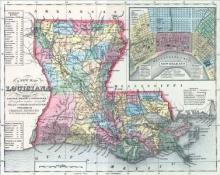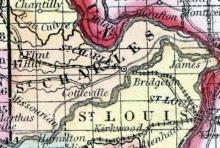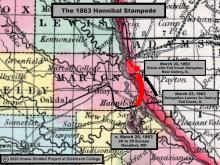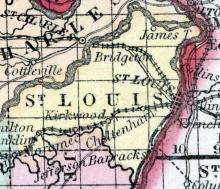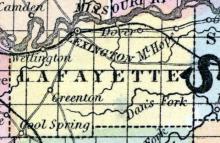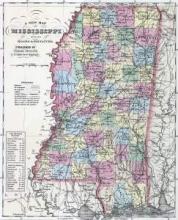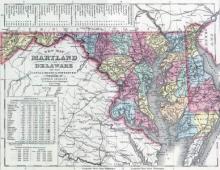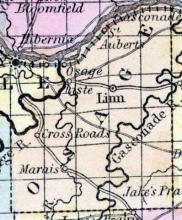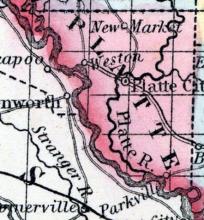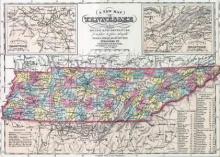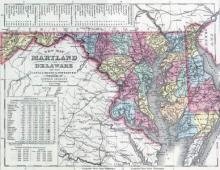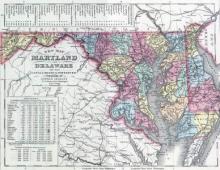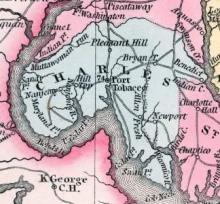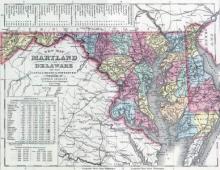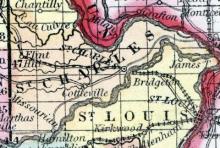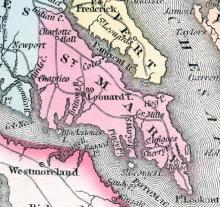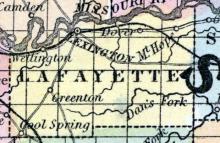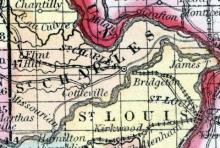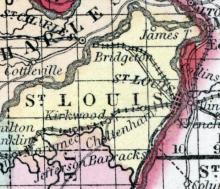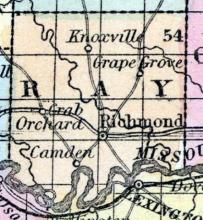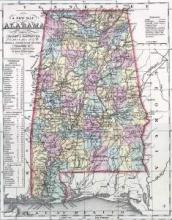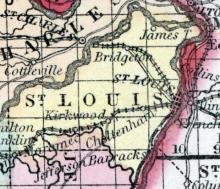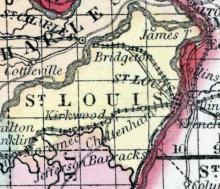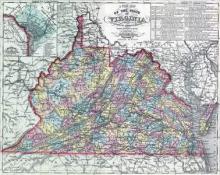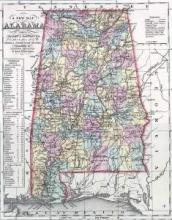In February 1863, a correspondent of the New York Times traveling with Gen. McPherson's 17th Corps in Louisiana during Grant's Vicksburg campaign reported encountering hundreds of runaway slaves. The Massachusetts newspaper which excerpted his account in mid-March, then labeled it "a complete stampede of negroes, old and young, from the Bayou Macon region," and claimed that "the remaining slaves are a source of more anxiety to the rebels than even the Yankees."
View All Escapes // 1840s // 1850s // 1860s
Displaying 451 - 476 of 476
An enslaved man named Archer Alexander, a spy for Union military forces, fled slavery in St. Charles county, Missouri, escaping to St. Louis where he found protection from the U.S. army. Alexander later became immortalized as the model for the liberated ex-slave featured with Abraham Lincoln in the Emancipation Memorial in Washington, DC, sculpted by Thomas Ball and dedicated in 1876 by Frederick Douglass.
In late March 1863, Wash Minter and 20-25 enslaved Missourians escaped from Hannibal, Missouri into Quincy, Illinois.
On Saturday night, April 11, 1863, three enslaved people, Jerry, Louis, and Nathan, escaped from slaveholder Olly Williams's farm on the St. Charles Rock road outside St. Louis. The three freedom seekers left in Williams's wagon, guided by two mules and packed full with "other property" of their slaveholder.
On Friday night, April 24, 1863, a group of around 50 enslaved Missourians escaped from Lafayette county, Missouri, bringing with them six wagons, 18 horses and a carriage. Lexington papers reported that the group was among the "not less than three hundred slaves" who had escaped from the county over the preceding three weeks. "These slaves all go to Kansas," a report added.
Around the beginning of June 1863, a correspondent for the New York Herald reported from Walnut Hills, near Vicksburg, that "Hundreds of negroes stampeded at the approach of our troops, and followed them into our lines."
In early June, newspaper reports claimed 60 freedom seekers had fled from multiple slaveholders in Annapolis, Maryland in what they termed "a wholesale stampede." Some of the named slaveholders included Charles Hammond, William Anderson Randolph, and Abraham Woodward. Newspapers reported that the runaways were "supposed to have gone to Washington, D.C."
On Wednesday, July 22, 1863, a group of four enslaved people, a roughly 46-year-old man named Lewis, a 40-year-old woman named Clarissa, a 29-year-old named George, and a 16-year-old named Peter, escaped from Chamois, Missouri. Slaveholder James M. Sholer advertised a $100 reward for their recapture.
In early September, the Knoxville Register reported on "a large number of slaves" who had "absconded from different parts of this country our own neighborhood contributing to some extent, to the exodus." The newspaper glumly concluded: "At the rate at which this thing has been going on for some time past, our country must soon be drained of this species of population." A Milwaukee newspaper reprinted this story along with the tale of the simultaneous stampede of enslaved
In mid September 1863, there were reports that earlier in the month there had been a number of stampeding slaves from around Pikesville, Maryland. One newspaper noted, "there seems to be a general exodus of them in that portion of the county," adding, "If this state of things continue, and it undoubtedly will, in short time there will not be an able bodied slave in that section of the country."
On Monday, September 7, 1863, a reported group of 50 enslaved people "undertook a stampede" from slaveholders in both Anne Arundel and Calvert counties, Maryland. The group was reportedly heading toward Washington until they were cornered by a local slave patrol. According to newspaper accounts, "The inferior quality of the stampeders' fire-arms enabled the citizens to capture them after having wounded a number."
On Sunday, September 13, 1863, there were reports that at least 15 enslaved African Americans, including "men, women, and children," from Cedar Point Neck in Charles county, Maryland had escaped. According to the news account, which was reprinted nationally, the group stole "a large flat-bottomed boat" from a barn, "which they carried to the creek, and thus made their escape." A Port Tobacco, Maryland newspaper reported that "not less than fifty negroes from this v
Around Sunday or Monday, October 11-12, 1863, there was a "stampede of slaves" in Port Tobacco, Maryland that received attention as far away as Charleston, South Carolina. The local newspaper originally reported that there was "an exodus of forty or fifty from the neighborhood of Pomonket," adding glumly, "At this rate our county is likely to be entirely drained of available working labor in a very short time."
On Wednesday, October 14, 1863, an enslaved man named Peter Lewis, around 20 years old, escaped from Hamburg in St. Charles county, Missouri. His enslaver, J.D. Hutchison, advertised a $50 reward for Lewis's recapture.
On Saturday night, October 17, about 50 enslaved men escaped from near Leonardtown, Maryland. It marked the latest in a series of mass escapes that had rocked Maryland slaveholders to their core. The editors of the St. Mary's Beacon connected the escape to the US army's growing efforts to recruit enslaved Marylanders.
Around Sunday, November 29, 1863, three enslaved men escaped from the farm of Col. Chiles, near Lexington, Missouri, taking with them "three horses and a wagon and left for Kansas." The Lexington Union reported their escape as part of a wave of "negro stampeding" during the winter of 1863-1864. The three men were reportedly halted by U.S. authorities and placed "in the U.S. service."
The family of Archer Alexander, his wife Louisa and children Ellen and James, escaped from Naylor's Station in St. Charles county, rejoining Archer in St. Louis where they obtained protection from the U.S. military.
On Monday, December 7, 1863, an enslaved woman, who was not named, and her young child, escaped from the home of slaveholder John F. Diers at 71 N. Tenth Street, St. Louis. Diers advertised a reward for their return.
In Ray county, Missouri, thirty enslaved people formed a "stampede" to the U.S. recruiting offices and enlisted in the U.S. Colored Troops.
In early February, about 150 freedom seekers from around Huntsville, Alabama passed through Stevenson in the northern part of the state on their way toward Nashville, Tennessee.
On Tuesday night, March 15, 1864, a 11-12 year old enslaved girl named Mimy escaped from the house of slaveholder M.A. McDonnald at 202 N. 6th Street in St. Louis. McDonnald advertised a $25 reward for her recapture.
In May 1864, various newspapers began reporting on the influx of enslaved families at military recruiting centers across Kentucky. One Cincinnati newspaper wrote: "Within a few days the negroes of Kentucky have become impressed with the idea that the road to freedom lies through military service, and there has been a stampede from the farms to the recruiting offices." By April 1865, the Louisville Journal was writing that "Hundreds and thousands of negroes
On Friday, July 15, 1864, a 13-year-old enslaved boy named Caley Brant escaped from Washington Hall in St. Louis. His enslaver advertised a $50 reward.
Near the end of December 1864, there was a rush of freedom seekers from Richmond, Virginia toward Union lines near the city. Richmond newspapers reported on the flight and attributed it to rumors that enslaved Black men were about to be impressed into the Confederate army. The Sentinel wrote: "A regular panic and stampede has taken place among the negroes of this city.
In early January 1865, Confederate-controlled Montgomery, Alabama experienced a disturbance involving some enslaved Black males who clashed with local authorities. According to newspaper reports, local police stumbled onto a crowd of Blacks who had taken over a "grog shop" and thereby provoked "a general stampede." Police managed to arrest "five lusty descendants of Ham," whom they identified as Pero (slaveholder Ousby), Sandy (slaveholder Ashley), Joel (slaveholder Pric

